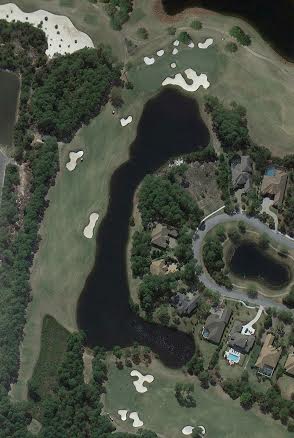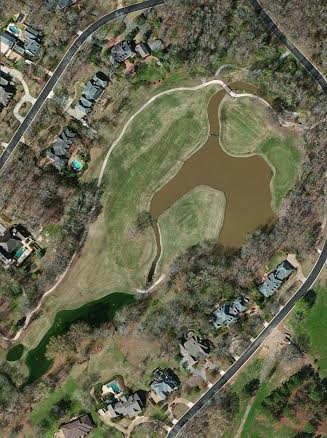Instruction
Does a certain hole have you stuck in Groundhog Day?

What if I told you that you had to eat the same thing for breakfast, lunch and dinner every day for a month? Or you had to wear the same clothes for a month. Would you do it? Most of us would say “No way!” The iconic Bill Murray movie Groundhog Day presents just that situation. The “same old, same old” every day, such that you can predict the exact outcome.
It seems that one of the “game play” things I am consistently troubleshooting with my players is how they navigate the course. A lot of times it is with a member who is having trouble on a course they play several times a week, so there is an adverse familiarity with the layout — sometimes way too familiar. They tee the ball up in the same place (and the tee markers rarely move far enough to change the strategy/club selection), hit the same club and get stuck repeatedly with the same result. It’s like “Groundhog Day” every time they play that hole. They are stuck in an endless loop of the same error over and over again.
Below are two stories from two players of different skill sets — a PGA Tour player and a player at my academy course. They both had specific holes that gave them fits.
Academy player
Jerry is a member that I have worked with for several years and his handicap has progressively dropped from 12 to 5. He hits the ball with a nice little draw throughout his bag and has become a very consistent ball striker.
Recent history had him struggling with our 7th hole. It is a double-green, par-4 of average length with water all the way up the right side and a green that tilts toward the hazard on the right. It has a big runoff to a grass valley on the left of the gree n. The low area, which sits several feet lower than the putting surface that runs away from you, is dead. Jerry hits that fairway nine times out of 10, but just can’t shake a miss to the left that leaves him in the valley of death. He would come up to me and tell me about his bogey or double on No. 7 from the middle of the fairway after every round.
n. The low area, which sits several feet lower than the putting surface that runs away from you, is dead. Jerry hits that fairway nine times out of 10, but just can’t shake a miss to the left that leaves him in the valley of death. He would come up to me and tell me about his bogey or double on No. 7 from the middle of the fairway after every round.
On EVERY approach, he would have a full 7 or 8 iron and hit it left, no matter what he tried to do mentally. It was a hook or a pull into that spot like a magnet. It got to be such a joke that I told him if he did it again that the club was going to put a plaque there with his name on it.
So after one round, where he told me of another miss left, I asked him to go through the last few times he played that hole and his entire process for the approach. What he described was the same for every approach; visualize a nice high draw, take a practice swing and feel the shot, pick his target and then setup and swing. Invariably, the ball went left into the valley of doom. So I told him, let’s do something different. Familiarity can breed repetition if we are not careful. We just get into a robotic mode of making the same decision without conscious thoughts and analysis.
What I proposed was hitting a different approach shot. We chose a little knockdown shot for the next time he played the hole. Then the time after that I wanted him to hit a little cut in there. Then a draw. Then a three-quarter shot. It didn’t matter what it was, I just wanted a different shot into that green for the next five times he played the hole. And guess what — it worked! He started to hit the green regularly. We found a go-to shot where he’d consistently hit the green.
This helped him make a few pars and the occasional birdie. It got so much better we were forced to put the plaque on hold.
PGA Tour player
I was working with a player out on Tour a couple of years ago and we were at the Sanderson Farms Championship when it was played at Annandale GC. He was telling me of his continuous struggles with the 17th hole — I could tell it gave him nightmares. He loved the rest of t he layout, but No. 17 really got under his skin for whatever reason. The tee shot just did not fit his eye, which subsequently made finding a workable ball flight and shot shape to play the hole a big issue. I always tell my players that every course will have a hole or two that gives you fits. You have to find a way to play those holes and avoid a double or triple bogey that will blow up your scorecard.
he layout, but No. 17 really got under his skin for whatever reason. The tee shot just did not fit his eye, which subsequently made finding a workable ball flight and shot shape to play the hole a big issue. I always tell my players that every course will have a hole or two that gives you fits. You have to find a way to play those holes and avoid a double or triple bogey that will blow up your scorecard.
Here’s how we fixed it.
Instead of playing a full practice round, I suggested we play just that hole until he loved it. Why bother with the other ones you know you can play well? So we went out to No. 17 and discussed what has happened in the past.
- What club he normally tried to hit?
- What shot shape did he try to put out there?
- What did he see as he visualized the shot?
After lots of data was shared, we chose several shot shapes with different clubs. I had his caddy pull out a few balls and we stood on the tee and hit four or five shots until he settled on a flight and shape with a club he felt would easily hit the fairway. Over the course of the event, he hit the fairway every time and made steady pars using the club, flight and shape we determined on the tee during the practice session.
So what’s the lesson? Next time you step on your “Groundhog Day” hole, commit to a different shot than the one you’re used to playing — one that makes you feel more comfortable. It may just open the floodgates for success on that hole in the future!
- LIKE42
- LEGIT10
- WOW2
- LOL0
- IDHT0
- FLOP0
- OB0
- SHANK0
Instruction
Clement: Laid-off or perfect fade? Across-the-line or perfect draw?

Some call the image on the left laid off, but if you are hitting a fade, this could be a perfect backswing for it! Same for across the line for a draw! Stop racking your brain with perceived mistakes and simply match backswing to shot shape!
- LIKE0
- LEGIT0
- WOW0
- LOL0
- IDHT0
- FLOP0
- OB0
- SHANK1
Instruction
The Wedge Guy: The easiest-to-learn golf basic

My golf learning began with this simple fact – if you don’t have a fundamentally sound hold on the golf club, it is practically impossible for your body to execute a fundamentally sound golf swing. I’m still a big believer that the golf swing is much easier to execute if you begin with the proper hold on the club.
As you might imagine, I come into contact with hundreds of golfers of all skill levels. And it is very rare to see a good player with a bad hold on the golf club. There are some exceptions, for sure, but they are very few and very far between, and they typically have beat so many balls with their poor grip that they’ve found a way to work around it.
The reality of biophysics is that the body moves only in certain ways – and the particulars of the way you hold the golf club can totally prevent a sound swing motion that allows the club to release properly through the impact zone. The wonderful thing is that anyone can learn how to put a fundamentally sound hold on the golf club, and you can practice it anywhere your hands are not otherwise engaged, like watching TV or just sitting and relaxing.
Whether you prefer an overlap, interlock or full-finger (not baseball!) grip on the club, the same fundamentals apply. Here are the major grip faults I see most often, in the order of the frequency:
Mis-aligned hands
By this I mean that the palms of the two hands are not parallel to each other. Too many golfers have a weak left hand and strong right, or vice versa. The easiest way to learn how to hold the club with your palms aligned properly is to grip a plain wooden ruler or yardstick. It forces the hands to align properly and shows you how that feels. If you grip and re-grip a yardstick several times, then grip a club, you’ll see that the learning curve is almost immediate.
The position of the grip in the upper/left hand
I also observe many golfers who have the butt of the grip too far into the heel pad of the upper hand (the left hand for right-handed players). It’s amazing how much easier it is to release the club through the ball if even 1/4-1/2″ of the butt is beyond the left heel pad. Try this yourself to see what I mean. Swing the club freely with just your left hand and notice the difference in its release from when you hold it at the end of the grip, versus gripping down even a half inch.
To help you really understand how this works, go to the range and hit shots with your five-iron gripped down a full inch to make the club the same length as your seven-iron. You will probably see an amazing shot shape difference, and likely not see as much distance loss as you would expect.
Too much lower (right) hand on the club
It seems like almost all golfers of 8-10 handicap or higher have the club too far into the palm of the lower hand, because that feels “good” if you are trying to control the path of the clubhead to the ball. But the golf swing is not an effort to hit at the ball – it is a swing of the club. The proper hold on the club has the grip underneath the pad at the base of the fingers. This will likely feel “weak” to you — like you cannot control the club like that. EXACTLY. You should not be trying to control the club with your lower/master hand.
Gripping too tightly
Nearly all golfers hold the club too tightly, which tenses up the forearms and prevents a proper release of the club through impact. In order for the club to move back and through properly, you must feel that the club is controlled by the last three fingers of the upper hand, and the middle two fingers of the lower hand. If you engage your thumbs and forefingers in “holding” the club, the result will almost always be a grip that is too tight. Try this for yourself. Hold the club in your upper hand only, and squeeze firmly with just the last three fingers, with the forefinger and thumb off the club entirely. You have good control, but your forearms are not tense. Then begin to squeeze down with your thumb and forefinger and observe the tensing of the entire forearm. This is the way we are made, so the key to preventing tenseness in the arms is to hold the club very lightly with the “pinchers” — the thumbs and forefingers.
So, those are what I believe are the four fundamentals of a good grip. Anyone can learn them in their home or office very quickly. There is no easier way to improve your ball striking consistency and add distance than giving more attention to the way you hold the golf club.
More from the Wedge Guy
- The Wedge Guy: Golf mastery begins with your wedge game
- The Wedge Guy: Why golf is 20 times harder than brain surgery
- The Wedge Guy: Musings on the golf ball rollback
- LIKE86
- LEGIT13
- WOW6
- LOL1
- IDHT0
- FLOP4
- OB1
- SHANK8
Instruction
Clement: Stop ripping off your swing with this drill!

Not the dreaded headcover under the armpit drill! As if your body is defective and can’t function by itself! Have you seen how incredible the human machine is with all the incredible feats of agility all kinds of athletes are accomplishing? You think your body is so defective (the good Lord is laughing his head off at you) that it needs a headcover tucked under the armpit so you can swing like T-Rex?
- LIKE0
- LEGIT2
- WOW2
- LOL0
- IDHT0
- FLOP0
- OB0
- SHANK2
-

 19th Hole2 weeks ago
19th Hole2 weeks agoDave Portnoy places monstrous outright bet for the 2024 Masters
-

 19th Hole3 days ago
19th Hole3 days agoJustin Thomas on the equipment choice of Scottie Scheffler that he thinks is ‘weird’
-

 19th Hole2 weeks ago
19th Hole2 weeks agoTiger Woods arrives at 2024 Masters equipped with a putter that may surprise you
-

 19th Hole3 days ago
19th Hole3 days ago‘Absolutely crazy’ – Major champ lays into Patrick Cantlay over his decision on final hole of RBC Heritage
-

 19th Hole2 weeks ago
19th Hole2 weeks agoTwo star names reportedly blanked Jon Rahm all week at the Masters
-

 19th Hole1 week ago
19th Hole1 week agoReport: LIV Golf identifies latest star name they hope to sign to breakaway tour
-

 19th Hole1 week ago
19th Hole1 week agoNeal Shipley presser ends in awkward fashion after reporter claims Tiger handed him note on 8th fairway
-

 19th Hole1 week ago
19th Hole1 week agoBrandel Chamblee has ‘no doubt’ who started the McIlroy/LIV rumor and why
















Golfraven
Feb 3, 2015 at 3:05 pm
You would think it was common sense to play different shot if the usual strategy is not successful or consistent. BUT we golfers are nature of habit and just won’t accept change at times. I like the idea of playing same hole over and over again until you figured it out. I play same course 99% of time and at times I just don’t thing what I suppose to do because I play the usual shots rather being more creative or look at alternatives. Will get this advise t heart.
Rob Strano
Feb 5, 2015 at 9:45 am
You are right, we can become creatures of habit especially in golf. Have some fun next time you play that course. If you have a hole that has you stuck do something different with club or shot selection. One thing players tell me is that on some par 5’s they never go for it. Well go for it next time and you might surprise yourself and hit a memorable shot! Thanks for your comment…
Doc Todd
Feb 2, 2015 at 3:54 pm
Excellent article Rob! I have been having a similar conversation with my new club pro the past few weeks. My arch-nemesis hole at the club is our 16th and it is very similar to your academy player’s. For me, it is a medium length par four dog leg to the left with a large left sided water hazard (pond) that encroaches on the intended landing area for your tee ball. Predominate winds from the south push all shots toward the water hazard. If you choose driver from the tee you have a tiny landing area with water left and OB right. Most layup with a long iron to 3w which leaves you with a 150-180 yards to the green. The green has water nearly upto the fringe and the right side of the green has a large down slope from the cart path to the green. For me, I usually bailout to the right and play for the up and down rather than risk the draw/hook into the water. A nice knock down punch shot may fit the bill rather than play for the hill with a little draw.
Rob Strano
Feb 5, 2015 at 9:41 am
Thanks Doc for your comments. Like your thought about next time hitting a little punch shot in there. Get yourself out of Groundhog Day!